Hawker Siddely
Buccaneer S.MK 2B
“Avionics Upgrade Programme, ASR 1012”
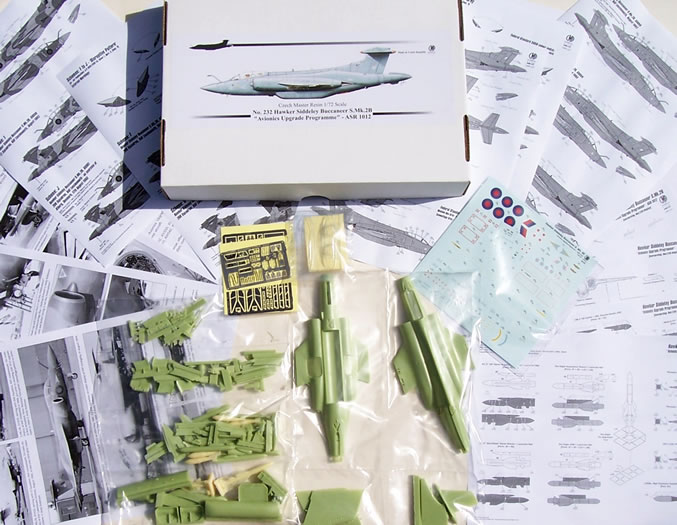
Czech Master Resin, 1/72 scale
S u m m a r y : |
Catalogue Number: |
Czech Master Resin Kit No. CMR232 - Hawker Siddely Buccaneer S.MK 2B “Avionics Upgrade Programme, ASR 1012” |
Scale: |
1/72 |
Contents & Media: |
113 x resin airframe parts, 1 x Eduard pre-coloured photo-etch (PE) fret, 1 x PE fret of mainly missile fin parts, 4 x vac-from acetate canopy parts, 1 x Eduard pre-cut paint mask, and decals for 10 colour schemes. |
Price: |
Available online from Hannants for £66.00, West Coast Hobbys for Cn$99.00, and various other CMR stockists. (Click here for currency conversion) |
Review Type: |
First Look |
Advantages: |
Highly detailed, thoroughly researched and very comprehensive kit. |
Disadvantages: |
The PE det-cord may be quite a challenge to fix satisfactorily to the canopy. |
Conclusions: |
CMR produces the definitive Buccaneer kits in any scale. Possibly more suited to modellers with some resin and multi-media experience. It looks like a straightforward build provided the instructions are studied thoroughly in advance and the choice of subject is made at the beginning of the build. A superb kit. |
Reviewed
by Mark Davies

HyperScale is proudly supported by Squadron.com
The Buccaneer really needs no introduction, having first served the RN in the 1960’s and then the RAF into the 1990’s, including operational service in the 1991 Gulf War. Conceived at a time when super-sonic performance was the benchmark for new military aircraft, the Buccaneer was unusual as a sub-sonic design. It was intended to operate in the low-level strike role from RN carriers at high sub-sonic speeds and in this respect anticipated later trends.
After disbandment of the RN’s carrier force the RAF adopted the Buccaneer. This followed the huge disappointment of the TSR-2 cancellation, and the follow-on cancelled procurement of TSR-2’s US replacement, the F-111. The RAF under these circumstances did not consider the Buccaneer the ideal aeroplane. But with time and experience in service the Buccaneer was recognised as a superlative strike aircraft.
Along with the Vulcan and Canberra, the Buccaneer was replaced by the Tornado. However the Tornado falls short of the Buccaneer in several areas - The Buccaneer had superior un-refueled range, higher cruising speed, twice the Sea Eagle missile load, and higher speed at lower levels with better crew comfort. Not bad for a plane developed in the 1950’s!
Obviously with such a long service life the Buccaneer received some upgrades. Aspects of the avionics upgrade covered by this kit are best explained by quoting historian Andy White who is a true Buccaneer expert (see http://www.blackburn-buccaneer.co.uk/). Andy has been of considerable assistance to CMR with research for their various Buccaneer kits. A slightly abridged version of the historical notes accompanying the kit is reproduced here with his permission.
"Avionics Upgrade Programme" - ASR 1012
[Incorporating: Mod.1736 wingtips]
In the Buccaneer’s role of ‘Maritime Strike’, it was capable of both Nuclear and Conventional weapon attack. Following completion of successful trials in October 1975, the AJ 168 ‘TV’ Martel (Ant-Ship) missile became primary attack weapons for both the Fleet Air Arm’s 809 NAS, aboard HMS Ark Royal and 12 Squadron, based at RAF Honington in Norfolk. A television display was mounted in the rear cockpit – between the Navigator/Observers’ knees. Using this, the missile operator could control the Martel ‘Anti-Ship’ missile on to its target, by means of a small joystick controller in the right hand. The disadvantage of this system was that the Buccaneer had to remain within operating distance of its intended target to ensure success, so making it vulnerable to attack itself.
In 1988 this weakness was finally resolved by the introduction of the Sea Eagle ‘Anti-Ship’ missile. The Sea Eagle is a true 'Fire and Forget' weapon, powered by a jet engine rather than a rocket, with four times the range of the 'TV' Martel – hence enabling the attacking Buccaneers to fly their attack profile; release their Sea Eagles; and return to base without ever appearing on the enemies' radar screens!
This missile began to be introduced into the Buccaneer force in December 1984, as part of an update programme (Mods.1724 to 1727). Initially a batch of 10 aircraft was made Sea Eagle compatible at RAF Lossiemouth between December 1984 and April 1986 – however these modifications were very limited. A second batch of 10 Buccaneers – undergoing major servicing at No.19 Maintenance Unit (MU), RAF St. Athan – received the same modifications, between April 1985 and September 1986.
ASR 1012
In 1986, the full "Avionics Upgrade Programme" ASR 1012 was initiated. This involved Buccaneers being released from front line service and flown to BAe Woodford for an extensive upgrade package. This consisted of:
- Installation of a new Flight Control System
- Incorporation of the Ferranti FIN 1063 Inertial Navigation System
- Fitment of TRACOR AN/ALE-40 Chaff and Flare Dispensers
- Modification of the Radar Warning Receivers to "Sky Guardian 200" - fitted in the former wing-mounted Wide-Band Homer aerial pods
- Full Sidewinder Air-to-Air Missile capability to mount the AIM-9G and AIM-9L
- Cockpit changes to facilitate operation by aircrew in full AR5 NBC (Nuclear, Biological, Chemical) clothing
Although 60 aircraft were scheduled to be upgraded, spiralling costs and major cutbacks during the 1987 defence review, only 42 Buccaneer S.Mk.2B were eventually modified. The following list details these 42 aircraft, plus when the avionics upgrade was completed for each of them.
Mod.1736
On the 7th February 1980 during Exercise ‘Red Flag 80’ (taking place at the Nellis Ranges, Nellis Air Force Base, Nevada, USA), Buccaneer S.Mk.2B, XV345 – serving with XV Squadron of the RAFG Laarbruch Wing in Germany – crashed during a violent manoeuvre, which caused the catastrophic failure of the starboard wing. Subsequent investigation found that a fatigue crack in the front spar caused the wing to fail, as it was unable to withstand the high loading experienced during the turn. Pilot: Sqn. Ldr. KJ Tait and Navigator: Flt. Lt. CR Ruston were both killed.
This accident caused the entire Buccaneer force to be grounded for an incredible 6 months.
Note: Because this happened during the height of the ‘Cold War’ a small number of Buccaneers were always maintained at ‘QRA’ [Quick Reaction Alert] – being a major part of ‘SACEUR’ [Supreme Allied Commander, Europe] in the ‘Nuclear Strike’ role.
Another two S.Mk.2B’s taken to Nellis by XV Squadron – XV864/S and XW538/T – were also found to be suffering from severe fatigue damage to their inner wing spars and were returned home to the UK by sea on 29th April 1980. At the same time during inspections of the Buccaneer force, another S.Mk.2B serving with 16 Squadron at RAFG Laarbruch – XV340/F – was found to have suffered similar fatigue and again returned by ship to the UK on 30th March 1980.
Overall, some 15 Buccaneers were ‘Withdrawn from Flying Status’ and a further 11 placed into storage at No.19 MU, RAF St. Athan. The grounding of the 'Buccaneer' force was finally lifted in August 1980, following completion of the necessary inspections and modifications.
On the 15th June 1982 the rebuilding of S.Mk.2C [ex-FAA non-Martel capable A/C.], XN982 was halted and instead transported by road to British Aerospace (BAe), Brough, East Yorkshire and attached to the fatigue-testing rig, to determine the cause of the crash of XV345. After the necessary simulated number of x1,000’s flying hours, it was finally determined that the actual cause had been the introduction of the enlarged triangular wingtip on the Rolls-Royce Spey-powered Buccaneer S.Mk.2 version.
Incredibly, no wing-loading tests had ever been done when these were introduced to increase the overall wing area of the Buccaneer S.Mk.2 to 514.7 sq. ft. – from the S.Mk.1 version’s 508.5 sq. ft. The reason for the triangular shape was so that the Buccaneer S.Mk.2 would still clear the internal height restriction of a Royal Navy Aircraft Carrier hangar, with its wings folded.
Therefore, as from August 1989, Mod.1736 was introduced. Basically this was the replacement of the existing S.Mk.2 wingtip with an adapted version of the original S.Mk.1 wingtip – being extended to full aileron chord, with navigation lamp at extreme rear end. This simple modification was found to give sufficient extension of airframe flying hours by reducing the overall wing loading. Initially fitted at BAe Woodford, these subsequently were fitted ‘in the field’ during routine maintenance at the Buccaneers’ home based of RAF Lossiemouth in Scotland.
Between August 1989 and October 1992 a total of 34 post-‘Avionics Upgrade Programme’ ASR 1012 aircraft received the Mod.1736 wingtips.
Note: In service, it was actually found that there was no adverse effect on performance, or operational ceiling, of those aircraft that had been fitted with Mod.1736 wingtips, compared to unmodified aircraft.
Author: Andy White
Copyright © 2011
Previous 1/72 Buccaneer Kits
There have been several 1/72 Buccaneer kits Airfix’s first effort was an S.1 although I think I have read it was close to the NA.39 prototype. Airfix later issued a generally quite reasonable S.MK2B. Matchbox and Frog also kitted the S.MK 2B, and these had their good and bad points like the Airfix Kit. Finally, and by far the best, was CMR’s first Buccaneer multi-media resin kit released about four years ago. It is this kit which has formed the basis for subsequent CMR Buccaneer releases. In each case these have been very highly researched, and Andy White has consulted with CMR on all of the major and minor variations associated with each Buccaneer version being kitted.
The kit comes packaged in CMR’s now standard sturdy top opening box. The parts and decals are in heat sealed plastic bags, which in turn are sealed in a further bag with the instructions and photo-walkaround. The straightforward instructions consist of no less than 17 A4 pages with very god quality graphics (see here). The parts map and constructional illustrations are very clear and easy to follow, as is the comprehensive painting and decal guide. Colour notes and other written instructions are in English. Six more pages provide a photo walkaround focused on various detail aspects of the aircraft, and another two with aircraft historical notes (reproduced above).
The kit’s resin parts are no longer in CMR’s usual cream colour; instead a pale green has been used. This change is to make the delicately cast detail more observable. Parts are very nicely with some small areas of mould flash in understandable places that should be very easy to remove.
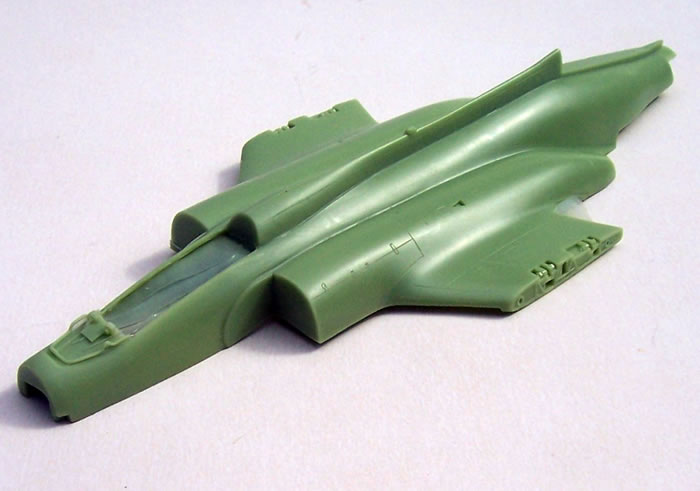
The kit is awash with detail, although some reviewers have suggested that the wheel wells would benefit from a bit more plumbing in them. I’m inclined to agree, although they are still good. Considerable attention has been paid to providing optional position parts. Detail levels are further enhanced by the pre-coloured Eduard PE set provided, which includes some very nicely done seatbelts.
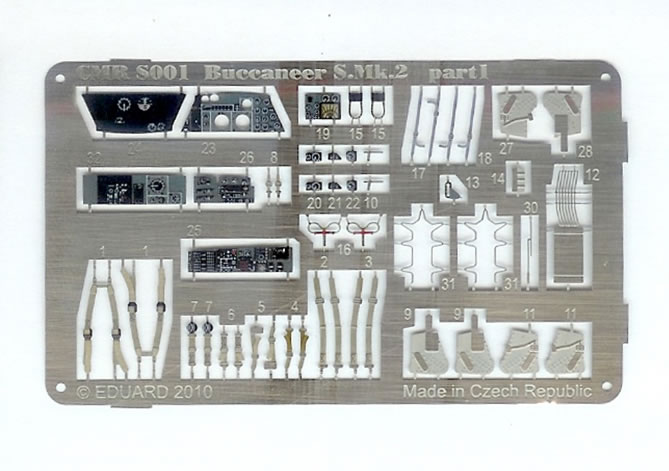
Rather than give a blow by blow account of the kit parts I’ll rely on the accompanying images and list options and weapons choices.
Optional position parts include:
-
Hinged nose.
-
Open or closed canopy.
-
Folded or fixed wings.
-
Optional flap positions.
-
Open bomb bay.
-
Original or bulged bomb bay door with fuel tank.
-
Retracted or lowered tail-hook and skid.
-
Choice of airbrake styles.
-
Open or closed airbrakes.
The weapons selection is substantial:
-
2 x AS 37 AR acquisition rounds / AS 37 Anti Radar Martel Missile with resin fins.
-
4 x Sea Eagle Missile or acquisition rounds with PE fins.
-
1 x AIM-9 Sidewinder acquisition round.
-
1 x AIM-9G, with PE fins. 1 x AIM-9L, with PE fins.
-
1 x AN/AVQ-23E Pave Spike laser designation pod.
-
1 x AN/ALQ-101 ECM pod. 4 x 1000lb bombs, high explosive substitutes [HES], with fins cast on.
-
1 x Paveway II 1000lb HES bomb cast with fins and guidance warhead. 2 x CBLS 100 practice bomb carriers.
-
4 x 28lb practice bombs.
-
2 x 250-gallon slipper tanks.
-
2 x AN/ALE-40 Chaff dispensers.
There are comprehensive guides concerning weapons fits (see here and here) showing what should go with which colour scheme and so on, as well as dimensional locations for weapons pylons. I would recommend that builders spend some time studying this aspect of the kit, and note that the weapons fit are cross-referenced to the various colour schemes, reflecting observed payloads for the aircraft concerned. The plain PE fret has numerous missile fins as indicated in the list above, as well as a jig to assist with locating these.
The kit’s canopy comes in the usual vac-form acetate, of which two copies provide for insurance or practice when cutting out. You also get vac-formed blast screens to go between the seats. The canopy comes with an Eduard pre-cut mask which serves to make life easy when it comes to painting. (Regrettably my lack of photography skills means I only have a rather poor photo of these parts due to reflection problems.)
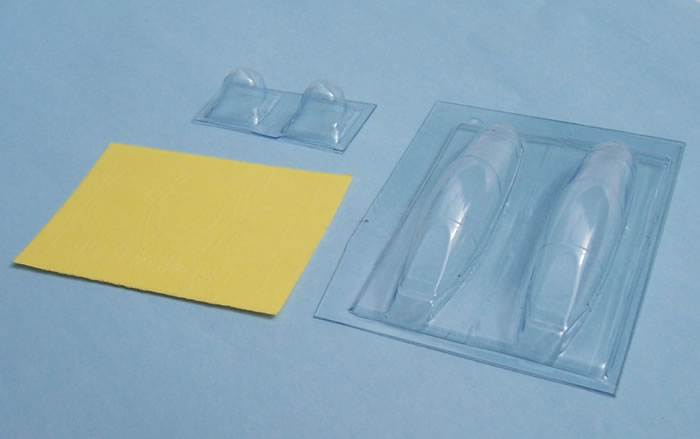
The PE set provides the ejection det-cord to be attached inside the canopy. I assume that this is because a vac-formed representation would be too soft and blurred. Fitting this will be a challenging task I feel (it would be for me at least!), and I’d be inclined to practice on spare canopies with scrap PE. I think that a coat of Future will provide some protection from super-glue or other methods of bonding the det-cord. I wonder if an Eduard pre-cut paint mask would work? Although this too would be tricky to position inside the curve of the canopy, but at least the risk of damage would be reduced.
At first the number of parts and sheer amount of information can make this appear a complex kit. But in fact assembly is quite conventional, aside from the horizontal split to the fuselage, and the build should be fairly straightforward.
It is clear that a huge amount of research has gone into this kit, and so familiarity with the options and a clear vision of which aircraft you plan to build will help avoid problems later in the build
Decals are typical of CMR, being well registered and suggest good opacity. 10 schemes are featured, five each in Air Superiority Grey or the Dark Green & Dark Sea Grey wrap-around disruptive camouflage.
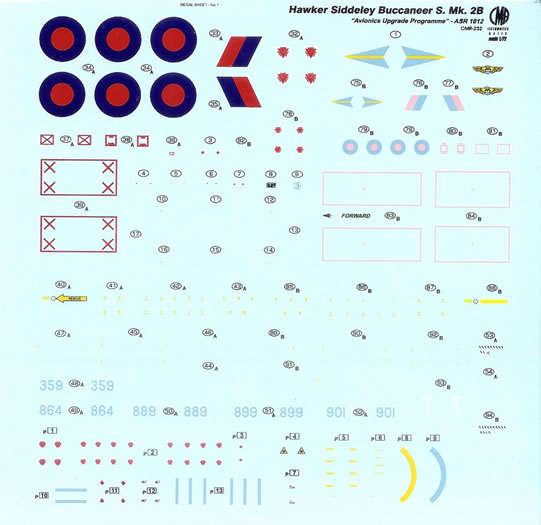
Paint call-outs include FS equivalents, and painting of small detail parts is well covered. . A nice touch I noticed on the painting guides is that they include the characteristic exhaust stains on the rear fuselage. An indication of the thoroughness of this kit is that there are two styles of tiny stencil decals for the picketing points that appear on the undercarriage legs, depending on which scheme you have chosen to model! The decal sheet is extensive and includes a quite small errata sheet covering an aircraft serial number (so mind you don’t biff this out with the bag like I almost did!)
This is a superbly executed kit with high levels of detail and a plethora of options, yet it looks to be a fairly straightforward build. It is produced to a very high standard with a wealth of information and photos concerning the subjects covered by the kit (In my experience at least, this aspect is unequalled by any other brand I’m familiar with). The degree of research that has gone into the kit is phenomenal, whether applied to the airframe, weapons choices or markings variations.
Yes, the kit is an expensive when compared to injection moulded jet subjects of similar size, but not so when compared to similar sized resin kits produced to comparable standards. Value for money will depend on your point of view and what you’re looking for. But if you want the definitive kit of the Buccaneer in any scale then this or one of the other CMR Buccaneers is the kit for you. If you need any more convincing take a look at this image of three finished CMR Buccaneer models at the 2007 Nurnberg Hobby Exhibition where it was awarded Best Kit of the Year 2006 in the category of "Aircraft models in 1/72 scale produced in limited series"
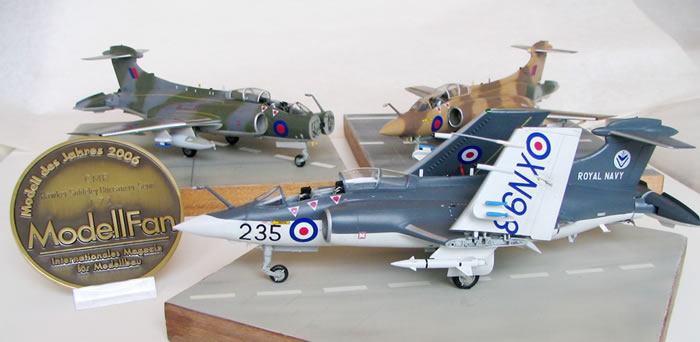
(Models built by: Jaromir Senft - front & top right, and Colin Pickett – top left)
Highly recommended.
Thanks to Czech Master Resin for this review sample.
CMR Models are available
online from Hannants in the UK,
Red Roo Models in Australia
and
quality specialist model retailers worldwide.
Text Copyright © 2011 by Mark Davies
This Page Created on 14 April, 2011
Last updated
14 April, 2011
Back to HyperScale
Main Page
Back to Reviews
Page
 |
